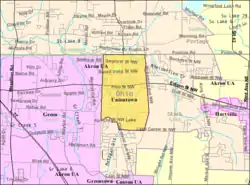Uniontown, Ohio | |
|---|---|
 Location of Uniontown, Ohio | |
 Detailed map of Uniontown | |
| Coordinates: 40°58′35″N 81°24′26″W / 40.97639°N 81.40722°W | |
| Country | United States |
| State | Ohio |
| County | Stark Summit |
| Township | Lake |
| Area | |
| • Total | 4.20 sq mi (10.89 km2) |
| • Land | 4.18 sq mi (10.83 km2) |
| • Water | 0.02 sq mi (0.06 km2) |
| Elevation | 1,119 ft (341 m) |
| Population (2020) | |
| • Total | 7,173 |
| • Density | 1,715.21/sq mi (662.21/km2) |
| Time zone | UTC-5 (Eastern (EST)) |
| • Summer (DST) | UTC-4 (EDT) |
| ZIP code | 44685 |
| Area code | 330 |
| FIPS code | 39-78736[3] |
| GNIS feature ID | 1065407[2] |
Uniontown is a census-designated place (CDP) in Stark County, Ohio, United States. The population was 7,173 at the 2020 census.
The Industrial Excess Landfill, now a superfund site, is located south of Uniontown.[4]
Uniontown is part of the Canton-Massillon, OH Metropolitan Statistical Area.
History
Uniontown was platted in 1816.[5] Two stagecoach lines which met near the original town site caused the name "Union" to be selected.[6] By the 1830s, Uniontown had a church, schoolhouse, tannery, tavern, and two stores.[7] A post office called Uniontown has been in operation since 1920.[8]
Superfund Site
A pit from prior sand and gravel mining was turned into a landfill in 1966, the so called Industrial Excess Landfill (IEL), which accepted solid and liquid waste of Akron's rubber industry as well as black shale and coal ash, military waste, and various other industrial wastes including plutonium, according to former landfill owner Charles Kittinger. The 30 acre landfill closed in 1980 and left soil and groundwater contamination behind, with recurring plumes of toxic vapors for years to come.[9] In 1983, concerned citizens raised the issue of health effects from IEL's contamination.[10] EPA listed IEL as a Superfund site in 1984. They determined that a toxic plume moved in a radial pattern away from the site in all directions. A soil vapor intrusion control system was installed in areas where residents could not be evacuated. In 1989, EPA hired Tetra Tech to conduct cleanup efforts.[10] In 2004, EPA considering the clean-up finished and shut down monitoring wells.[9]
Geography
Uniontown is located along the Tuscarawas River.[11]
According to the United States Census Bureau, the CDP has a total area of 2.5 square miles (6.5 km2), of which 2.5 square miles (6.5 km2) is land and 0.04 square miles (0.10 km2) (0.79%) is water.
Demographics
| Census | Pop. | Note | %± |
|---|---|---|---|
| 2020 | 7,173 | — | |
| U.S. Decennial Census[12] | |||
Uniontown is part of the Canton-Massillon, OH Metropolitan Statistical Area. At the 2000 census there were 2,802 people, 1,141 households, and 861 families in the CDP. The population density was 1,122.5 inhabitants per square mile (433.4/km2). There were 1,171 housing units at an average density of 469.1 per square mile (181.1/km2). The racial makeup of the CDP was 98.14% White, 0.32% African American, 0.14% Native American, 0.54% Asian, 0.14% from other races, and 0.71% from two or more races. Hispanic or Latino of any race were 0.50%.[3]
Of the 1,141 households 26.2% had children under the age of 18 living with them, 65.7% were married couples living together, 7.4% had a female householder with no husband present, and 24.5% were non-families. 21.5% of households were one person and 10.2% were one person aged 65 or older. The average household size was 2.46 and the average family size was 2.86.
The age distribution was 20.9% under the age of 18, 5.9% from 18 to 24, 24.6% from 25 to 44, 30.3% from 45 to 64, and 18.3% 65 or older. The median age was 44 years. For every 100 females there were 90.4 males. For every 100 females age 18 and over, there were 88.5 males.
The median household income was $47,206 and the median family income was $60,510. Males had a median income of $45,212 versus $28,625 for females. The per capita income for the CDP was $23,108. About 0.8% of families and 2.7% of the population were below the poverty line, including none of those under age 18 and 4.2% of those age 65 or over.
Education
Uniontown has a public library, a branch of Stark County District Library.[13]
References
- ↑ "ArcGIS REST Services Directory". United States Census Bureau. Retrieved September 20, 2022.
- 1 2 "US Board on Geographic Names". United States Geological Survey. 2007-10-25. Retrieved 2008-01-31.
- 1 2 "U.S. Census website". United States Census Bureau. Retrieved 2008-01-31.
- ↑ "Superfund Record of Decision" (PDF). United States Environmental Protection Agency Ohio. 1989-07-17. Archived from the original (PDF) on 2017-02-16. Retrieved 2020-08-23.
- ↑ Lehman, John H. (1916). A Standard History of Stark County, Ohio: An Authentic Narrative of the Past, with Particular Attention to the Modern Era in the Commercial, Industrial, Civic and Social Development. Lewis Publishing Company. p. 80.
- ↑ Overman, William Daniel (1958). Ohio Town Names. Akron, OH: Atlantic Press. p. 136.
- ↑ Kilbourn, John (1833). The Ohio Gazetteer, or, a Topographical Dictionary. Scott and Wright. pp. 455. Retrieved 12 December 2013.
- ↑ "Stark County". Jim Forte Postal History. Retrieved 21 January 2016.
- 1 2 Cooley, Patrick; clevel; .com (2017-01-26). "The 16 most toxic sites in Ohio, according to the EPA". Cleveland.com, Advanced Local Media. Retrieved 2020-08-23.
- 1 2 Burns, Karpani (2020-08-20). "2020 hindsight brings corrupted radiation testing into focus at the EPA – Part 1". San Francisco Bay View. Retrieved 2020-08-23.
- ↑ DeLorme (1991). Ohio Atlas & Gazetteer. Yarmouth, Maine: DeLorme. ISBN 0-89933-233-1.
- ↑ "Census of Population and Housing". Census.gov. Retrieved June 4, 2016.
- ↑ "Locations". Stark County District Library. Retrieved 3 March 2018.
